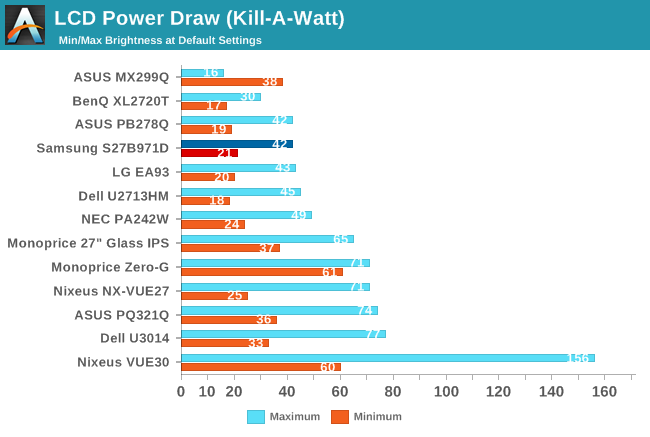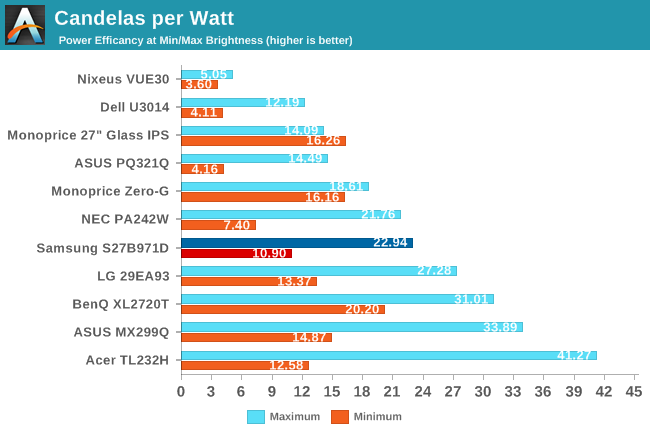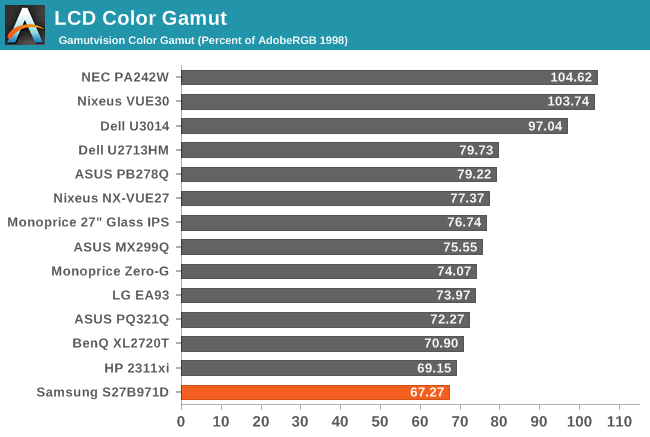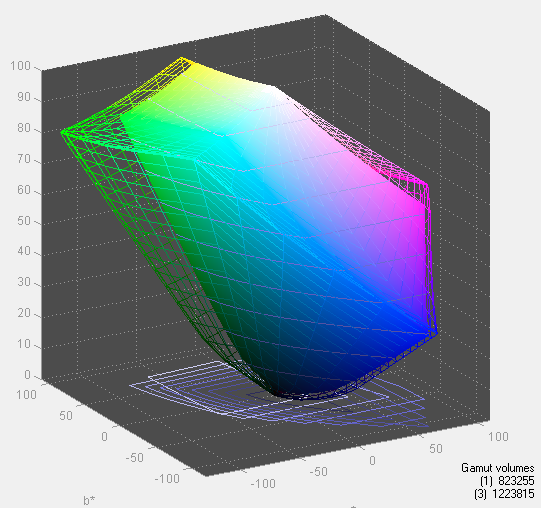Samsung S27B971D Monitor Review
by Chris Heinonen on October 31, 2013 12:00 PM ESTInput lag is tested over HDMI using the Leo Bodnar lag tester. It is limited to 1080p but it provides consistent, repeatable results that anyone can duplicate. A scaler can also be designed to introduce very little lag if implemented correctly so native resolution might provide better results, but it would be a slight difference (unless a poor/slow scaler is used).
Tested this way the Samsung S27B971D averages 26.3ms of lag. This is competitive with other 27” WQHD monitors that have produced 22.53 – 35.97ms of lag. Basically if you find any 27” WQHD monitor to be too slow, the Samsung won’t change your mind. I found nothing wrong with the overall gaming performance in my testing.

Power Use
Power draw from a Kill-A-Watt is reasonable on the Samsung with 21 watts at minimum backlight and 42 watts at maximum. On a candelas-per-square-inch-per-watt basis it comes in as being one of the most efficient monitors at maximum backlight and middle of the pack at minimum backlight. Now that virtually everyone uses LEDs, even for wide gamut displays, there probably won’t be as much difference here as there used to be.


Color Gamut
This is a bit interesting to me. In the sRGB mode the Samsung S27B971D falls short of the full sRGB gamut. It fills 67% of the AdobeRGB gamut, and not the 69% that we expect from sRGB. It’s a small difference but it is still a difference. If we switch to the standard color mode instead of sRGB then the gamut is larger. I ran the pre-calibration numbers, did a calibration in both modes, and ran the post-calibration numbers and found that the sRGB preset was far superior in the end. So while the gamut might come up just slightly low, it’s better than being over-saturated all around. In practice, very few people if any will notice the difference between 67% and 69%, as what we’re really looking for are displays that use significantly less than the sRGB gamut.












52 Comments
View All Comments
Bateluer - Thursday, October 31, 2013 - link
Meh, the DisplayPort and HDMI are nice, but I paid less than that for two 27in WQHD displays a year ago. Samsung, get this to a 4K resolution and you'll have buyers in 2014.TridenT - Thursday, October 31, 2013 - link
Typo in your second graphic: 1iProLolimaster - Friday, November 1, 2013 - link
And fix the awefull contrast, 500:1? What a joke.Minimum 1000-1100:1
cheinonen - Sunday, November 3, 2013 - link
The lower contrast will hurt performance for games and movies, yes. Typically on a display like this that is the trade-off to have a more uniform overall screen with a more controlled backlight. For many environments (graphic design, photography) the uniformity and color accuracy are both more essential than the contrast ratio.lkuzmanov - Friday, November 1, 2013 - link
Does anyone know why displays aren't being factory calibrated? Surely it must be technically possible.cheinonen - Sunday, November 3, 2013 - link
It is. Look at the recent NEC PA242W for an example. However that is a 24", 1920x1200 display that sells for over $1,100, so you are paying for that calibration.DaveGirard - Friday, November 1, 2013 - link
This looks like a great display for CG people where colour profiles are still AWOL with apps like ZBrush, Mudbox, etc. They assume you're using sRGB. But you still want a high-quality display. That said, it is a bit pricey compared to the dual Dell U2713HM monitors that I'm running quite happily.abhijeeth - Friday, November 1, 2013 - link
This is indeed slotted in a narrow niche: would have been so much better if it had support for AdobeRGB.The NEC PA271W can be purchased new at B&H Photo for $859 (no Spectraview + Calibrator bundle). But it is so good out of the box that you don't need an external calibrator. Downside is that is is CCFL and some units have an audible high pitched whine when high contrast images are displayed.
The NEC PA272W is just launched and will be available in the US on Nov 18th for $1299. LED Backlight, wide gamut coverage takes care of Adobe RGB requirements. Good warranty and dead pixel policy.
There is also the ASUS PA279Q for around $850 (wide Gamut). Pre Cal numbers aren't outstanding out of the box (dE < 2 claimed) but cleans up after post calibration. Has overshoot ghosting though.
Then there is the ViewSonic VP2772 for $990 (wide Gamut support).
In the 30inchers, the Dell U3014 is frequently on sale for $940ish. Can get a refurb directly from Dell for $640. Have to get Rev A03 though ;-)
There is the new HP Z30i (wide Gamut) for $1299.
All the new ones use LG's new semi glossy (satin/pearl finish) coating and not the grainy coatings of old 1st gen panels (the PA271W falls into this category unfortunately)
Having considered all this, the Samsung is indeed overpriced for what it offers. Stiff competition all around.
Alan G - Friday, November 1, 2013 - link
This monitor is dead in the water for anyone doing photography who needs an expanded color gamut. There's a reason why NEC monitors are the goto here. I don't care about how easy it is to use the OSD; I'm using software calibration.abhijeeth - Friday, November 1, 2013 - link
Alan,Agreed. By software calibration - are you using software to write to your video card LUT or the 14bit 3axis LUT inside the monitor. The interface bit depth is different (8 or 10bit per color depending on interface used) to the internal bit depth for storing the color info.
Using the monitor internal LUT has significant advantages for Color Management. ( you may be already aware of this, so, sorry if this is redundant). Just thought it might be worth mentioning.